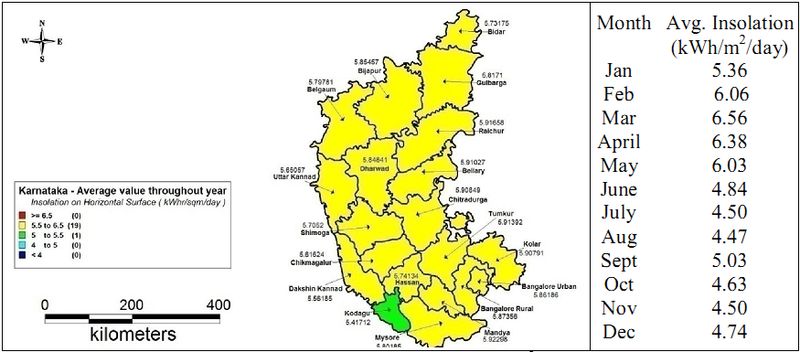Solar technologies such as Solar Photovoltaic (SPV) and Concentrated Solar Power (CSP) systems utilize solar radiation wavelengths between 0.29-5.5μm and major part of the spectrum gets attenuated in other wavelengths due to either absorption or scattering in the atmosphere [1]. The industrialization and consequent activities have increased the energy demand. Electricity meets a major portion of this energy demand and the energy from conventional sources accounts to 87.89%. The total installed generating capacity in the country has increased by 255% from 58,012 MW (1989) to 2,06,456 MW (2011) and average Transmission and Distribution (T&D) loss of 27.2% recorded during 2009-2010. Considering the growing environmental problems coupled with the diminishing stock of fossil fuels, the focus has to be on the renewable sources of energy, which as on today accounts to only 15,691.4 MW grid-connected plants and 367.9 MW off-grid plants. Centralized conventional power plants are unable to meet everyone’s demand evident from the absence of electricity in about 74 million households or nearly 32,800 un-electrified villages. This necessitates a decentralized, low-carbon, reliable, efficient and renewable options for energy generation. Key features of RE based generation are reduction of T&D losses, easier voltage management with flexible maintenance and reduced pilferages, scope for decentralized development at local levels with job opportunities due to the assured energy supply and availability of natural resources [2].
SOLAR ENERGY: SUSTAINABLE ENERGY OPTION: Energy consumption in Karnataka has increased gradually from 21698.23 GWh (2002-03) to 36975.2 GWh (2010-11). State is currently facing electric energy deficiency as consumption has exceeded the generation. Karnataka receives an average insolation of 5.55 kWh/m2/day annually. Insolation varies from 4.5 to 7 kWh/m2/day throughout the year (Figure 1). All districts of the state receive average insolation of 5.5 to 6.5 kWh/m2/day annually except Kodagu (5-5.5 kWh/m2/day) [1]. Electric energy can be harvested directly from available solar potential using solar photovoltaic (SPV) cells (modules).

Figure 1: Average annual solar insolation (kWh/m2/day) in Karnataka
About 68.43% of the population lives in rural areas of the state where the domestic electrical energy consumption ranges from 40 to 60 kWh per month per household. In rural area per capita energy consumption is about 10 to 12 kWh/month. This domestic demand can be supplied using solar PV installation on the rooftop where the average rooftop area available is 109.83 m2. Roof area required is about 4.12% (3.62 m2) of the total area available (η=10%, effective area = 80% of available area) to generate 60 kWh per month using rooftop solar PV technology,
RECOMMENDATIONS FOR SUSTAINABLE ENERGY DURING 21ST CENTURY
- Solar PV technology has the potential to meet the domestic and irrigation demands in the decentralized way. Appropriate policy incentives might help in the large scale deployment of solar devices at household levels. There is a need to focus on energy efficient decentralized electricity generation technologies with micro grid and smart grid architecture, which would go long way in meeting the energy demand. In this regard, suggestions are:
- Roof top based SPV would help in meeting the household energy demand in rural as well as urban households. Rural household require about 70-100 kWh per month and to meet this requirement 5-6 m2 rooftop is adequate (at η=10%, and insolation of 5 kWh/m2/day) and the average rooftop in rural locations in Karnataka is about 110 m2 and about 115 m2 in urban localities.
To supply electricity to households in remote areas entails investment on infrastructure apart from transmission and distribution (T&D) loss of electricity. Current assessment reveals that T&D loss in Karnataka is about 19.5% resulting in the loss of 7,210.16 GWh (annual demand is 36,975.2 GWh in 2010-11) or Rs. 5,047.11 crores (@ Rs. 7/kWh).
- Considering the current level of T & D losses in centralized system, inefficient and unreliable electricity supply, it is necessary to promote decentralized energy generation. Small capacity systems are efficient, economical and more importantly would meet the local electricity demand. The incentive could be
- Rs. 4.00 per unit for first five years (comparable to subsidies granted to mini hydel projects, the power purchase at Rs 3.40) and Rs.3.50 for the next two years for the electricity generated from roof top solar PV.
- Buyback programmes for the electricity generated at household level and in micro grid -GBI of Rs. 5 to be provided for electricity generation (< 5 kW) feeding to the grid by SPV.
- Free solar home lighting (with LED lamps) for economically disadvantaged sections of the society.
- All street lights and water Supply installations in local bodies to be energized through solar power (or hybrid mechanism) in a phased manner
- Install solar rooftops in all new government/local body buildings andin a phased manner in the existing government/local body buildings, etc.
- Exemption from payment of electricity tax to the extent of 100% on electricity generated from solar power projects to be allowed for at least10 years.
- Fixing of standards for quality installation.
- Commercial lighting in advertisement boards should only be from SPV panels.
- Capacity building of youth through technical education for installation and servicing of SPV panels.
- Setting up service centers in block development offices to meet the requirement of service support for RE technologies (Solar, biogas, energy efficient chulas, etc.).
REFERENCES
- Ramachandra T. V., Rishabh Jain and Gautham Krishnadas 2011. Hotspots of solar potential in India, Renewable and Sustainable Energy Reviews, vol. 15, Issue 6, 2011
- Ramachandra T V, 2011. Renewable energy transition: Perspective and Challenges, In: Energy India 2020- A Shape of Things to come in Indian Energy Sector, Saket Projects Ltd., Ahmedabad, Pp:175-183
|


